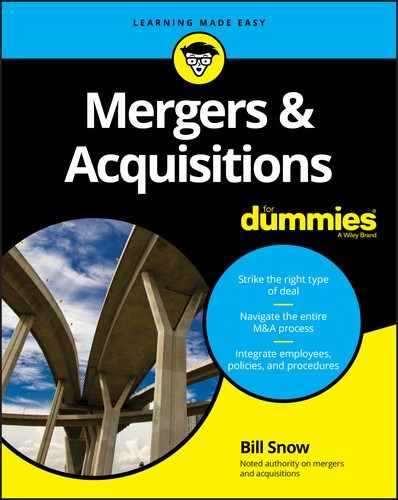Book Description
Mergers & Acquisitions For Dummies (9781119543862) was previously published as Mergers & Acquisitions For Dummies (9780470385562). While this version features a new Dummies cover and design, the content is the same as the prior release and should not be considered a new or updated product.
The easy way to make smart business transactions
Are you a business owner, investor, venture capitalist, or member of a private equity firm looking to grow your business by getting involved in a merger with, or acquisition of, another company? Are you looking for a plain-English guide to how mergers and acquisitions can affect your investments? Look no further.
Mergers & Acquisitions For Dummies explains the entire process step by step—from the different types of transactions and structures to raising funds and partnering. Plus, you'll get expert advice on identifying targets, business valuation, doing due diligence, closing the purchase agreement, and integrating new employees and new ways of doing business.
- Step-by-step techniques and real-world advice for making successful mergers and acquisitions
- Covers international laws and regulations
- How to take advantage of high-value deals
Going beyond the case studies of other books, Mergers & Acquisitions For Dummies is your one-stop reference for making business growth a success.
Table of Contents
- Cover
- Introduction
- Part 1: Mergers & Acquisitions 101
- Part 2: Taking the First Steps to Buy or Sell a Company
- Part 3: Starting the Deal on the Right Foot
- Part 4: Firming Up the Deal
- Chapter 11: An Insider’s Guide to M&A Negotiating
- Chapter 12: Crunching the Numbers: Establishing Valuation and Selling Price
- Chapter 13: LOI and Behold: Making or Receiving an Offer
- Chapter 14: Confirming Everything! Doing Due Diligence
- Chapter 15: Documenting the Final Deal: The Purchase Agreement
- Part 5: Closing the Deal … and Beyond!
- Part 6: The Part of Tens
- Chapter 19: Ten Considerations Prior to Signing an LOI
- Is the Deal Too Good to Be True?
- How Is the Buyer Financing the Deal?
- How Much Cash Is in the Offer?
- What Are the Conditions of Escrow?
- Is the Deal a Stock or Asset Deal?
- How Does the Deal Settle Working Capital Issues Post-Closing?
- Is the Inventory 100 Percent Salable?
- Who Pays Off Any Long-Term Debt and What Happens to the Line of Credit?
- What Are the Tax Implications of the Seller’s Accounts Receivable?
- Is the Seller Signing a Noncompete Agreement with the Buyer?
- Chapter 20: Ten Major M&A Errors and How to Avoid Them
- Assuming the Deal Is Done after the LOI Stage
- Being Unprepared for Due Diligence
- Asking for a High Valuation with No Rationale
- Figuring Buyers Won’t Discover Problems in the Financials
- Underestimating the Other Side’s Sophistication
- Failing to Understand Who Really Has the Power
- Withholding Material Information
- Blabbing about the Deal Before It Closes
- Calling the Seller’s Employees without Permission
- Contacting a Seller’s Customers or Vendors without Authorization
- Chapter 21: Ten Possible Ways to Solve Valuation Differences
- Chapter 19: Ten Considerations Prior to Signing an LOI
- Appendix
- About the Author
- Advertisement Page
- Connect with Dummies
- Index
- End User License Agreement
